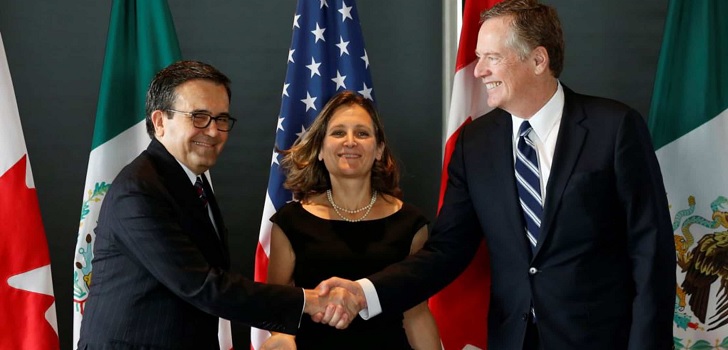The Mexican maquila ‘breathes’ a sign of relief with Usmca: fourteen months to return to the starting point
The Mexican fashion industry will be one of the least affected sectors of the Mexican economy in the new United States, Mexico and Canada Agreement (Usmca).

The “worse trade deal” of history wasn’t that bad after all. After a year of negotiations, Canada, the United States have renewed their commercial ties with an updated treaty between the three countries, which from now on will be named United States, Mexico and Canada Agreement (Usmca). The renewal of the deal is a relief for the Mexican fashion industry, which remained in suspense since the arrival of Donald Trump to the White House.
Since the New York tycoon became president of the United States, Mexico has been one of Trump’s victims and the Mexican maquila has followed closely the decisions taken by the president of his neighbouring country, which is also the main partner of the Mexican fashion industry.
During the last fourteen months of negotiations, the United States has shifted its rage and put China as its main enemy. This was evidenced as the US government first sealed a bilateral free trade agreement with Mexico last August, excluding Canada, which was reluctant to give in some points of the agreement.
The textile industry is one of the less harmed within the Mexican economy in the new Usmca free trade agreement
With the victory of Trump, the main concern of the Mexican fashion industry was the share of the Tariff Preference Levels (TPL), which regulated how many meters of cloth can be used from countries other than the members of the North American Free Trade Agreement (Nafta).
In a first revision of the agreement, the United States sought to eliminate the possibility of using raw material external to Canada or Mexico in the garments, especially to prohibit the entry of Chinese products into the US market.
“Fortunately, the quotas have remained stable to the values we have been operating for years,” said Pedro Góngora, president of the Yucatán delegation of the National Chamber of the Garment Industry (Canaive) of Mexico. “We don’t want to be so dependent on Asia, luckily the Usmca will not harm us,” he says.
Mexico has once again generated confidence for foreign investment after becoming a favourable partner for the United States
This is one of the main concerns of the Mexican textile industry because, if this section of Nafta was modified, the Aztec country is not a textile producer. By being only the maquila, the regulation of the rules of origin could drastically affect local production.
“To reach an agreement in the first instance with the United States and then with Canada is a vote of confidence for the entire Mexican industry,” insists Góngora. From becoming a “dangerous” adversary (in Trump’s words), Mexico has become the ideal partner for its neighbouring country.
“The United States is the ideal trade partner from which we must take advantage of the weaknesses that some fashion brands in that country are experiencing,” says the director of Canaive Yucatán. Góngora insists that the opportunity lies in the fact that giants such as Inditex or H&M will source in Mexico to cater for to the US market. “We offer logistic proximity and a greater possibility to respond quickly,” he adds.
Mexico has for the first time manufactured short series to supply foreign brands while the trade war between the United States and China is solved
The trade war with China has also generated a positive rebound effect for the Mexican fashion industry. “For the first time in history we have received orders to produce immediately what we previously did months in advance,” said Canaive in a statement. “As long as it isn’t known what will happen with US tariffs to China, the brands are demanding short and immediate production series,” says Góngora.
The governments of the three North American countries are considering possible dates for the signing of the new Usmca deal. Mexico intends to seal the agreement at the G20 summit that will be held on November 30 in Buenos Aires, so that President Enrique Peña Nieto will sign the treaty before the rise of Andrés Manuel López Obrador. The new agreement could become effective in the second half of 2019.


info@themds.com
Validation policy for comments:
MDS does not perform prior verification for the publication of comments. However, to prevent anonymous comments from affecting the rights of third parties without the ability to reply, all comments require a valid email address, which won’t be visible or shared.
Enter your name and email address to be able to comment on this news: once you click on the link you will find within your verification email, your comment will be published.